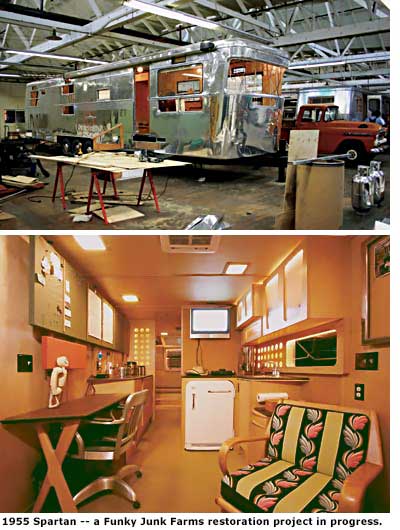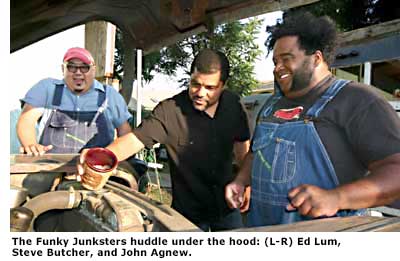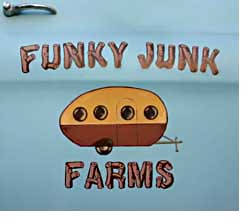On the Road Again: Trailers - Page 2
Agnew and Butcher are Teamsters who drive prop trucks and other vehicles for the movie studios. They met on the set of 'Pontiac Moon,' with Mary E. Steenburgen and Ted Danson, discovered a shared interest in old cars and other examples of antique Americana, and were soon searching out trailers and other treasures every weekend. Lum came into the picture when Agnew noticed his girlfriend's cool old Rambler sedan parked outside a coffee shop.
Funky Junk rents its trailers to the studios for movies, TV shows, and commercials. If the studios need authentic Art Deco cigarette machines, shelves filled with 1930s cleaning products, or handmade robots from the 1950s, Funky Junk's got that too. "I started collecting when I was a kid," Agnew says. "Everybody's got to have a boat motor collection, right?" he asks, as he leads a visitor past his.
But these days, trailers take pride of place. And while Agnew's got a Colonial-style 'Cottage Home' trailer from 1948, complete with white clapboard and shutters, the trailers that most stand out are those that are styled modern.

In the 1920s, trailers were a whole new building type—though they were rooted in covered wagons, stagecoaches, sheepherders' wagons, even private railcars. The Curtiss Aero-Car from the 1930s—several examples of which can be found at Butcher's shop—recalls the sort of railcar that 19th Century barons of industry once used.
Designers devised ingenious ways of saving space—hidden storage, built-in banquettes, tables that slip out of sight, diminutive sinks, showers and kitchens, and rooms that served for sleeping at night and living during the day. Interiors often recall 1930s California modernism, or even 1950s tract houses by Eichler, with mahogany plywood paneling, streamlined cabinetry, and indirect up-lighting. A 1952 Pan-American has sculptural shelves that suggest the half-living, half-dead creatures seen in 1940s surrealist painting by Yves Tanguy.
Everybody knows about the Airstream, of course. The only classic trailer still in production, Airstreams are polished aluminum, aerodynamically sound, well engineered, and much loved. Kerrie Aley, who buffs her aluminum, 1962 Airstream Bambi until it shines like a mirror, loves its shape, molded interior ("like the interior of a DC-3") and superb riveting. Aley, who used to design aircraft brake systems, speaks from experience. "They're built with aerospace technology," she says. "The thing is just really well-built."
How Kerrie and her husband Allan Songer came to own their Bambi shows how much owners love their trailers. Allan first spotted the trailer in Long Beach, where he and Aley live, and left a note saying he wanted it. Twelve years later he got a call from its owner, inviting them over. "She was interviewing us like we were adopting a pet," Aley remembers. They passed.

At Funky Junk Farms, however, 'Airstream' is almost a dirty word—not because they're not beautiful, but because they're too common. "It's like owning a Chevrolet or a Dodge," Agnew sniffs. "We've called Airstreams 'mainstreams.' " Butcher adds, "We're more into the rare type that were sometimes built by people who worked in the aerospace industry, and decided to build their own trailers."
Funky Junk Farms has quite a collection of homemade trailers, often based on kits. One charmer from the '30s has portholes for windows and a rear that pops open to become a screened porch. But they love factory-built trailers too. Agnew and Butcher brag about Spartan trailers, with their aluminum exteriors and wraparound windows. "Spartans are the epitome of the modern," Lum says.
Then there are the Shastas, with a cool 1950s look, with two-tone exteriors. "A lady's trailer," Agnew says of one 1956 model he's currently restoring for a lady.
Trailers have a rich history, and the Funky Junk collection covers much of it. Evolving in the mid-'20s from 'tent trailers,' travel trailers boomed in the mid-'30s. They provided cheap vacations, and homes for mobile workers and those seeking work. As the craze took hold, the number of manufacturers jumped from fewer than 50 in 1932 to 800 in 1936, according to Bryan Burkhart and David Hunt's in their book 'Airstream: The History of the Land Yacht.' Some trailers were called 'canned hams,' because of their shape, others 'breadboxes,' for the same reason. And there were tiny teardrop-shaped 'teardrops.'
By 1940, after the inevitable crash, the number of manufacturers was down to 40. Trailers boomed again in the 1950s as new highways made it easier to take to the road.





